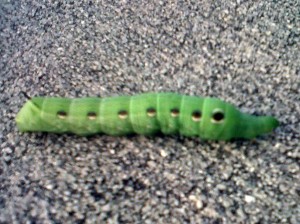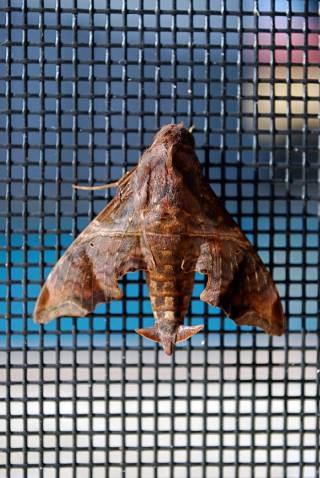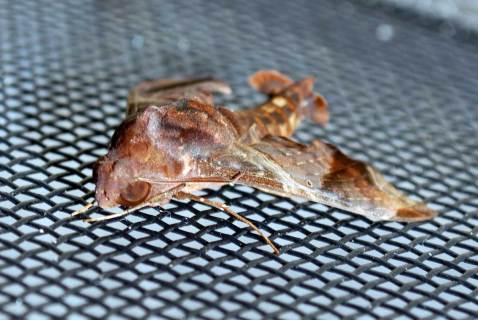City code here in Boca requires that if you have a pool, you also have a fence to keep toddlers from toddling in. Actually, it requires two lines of defense: a fence to keep neighborhood people out of the pool, then another fence to keep residents out of the pool. This pool fence is usually a fine nylon mesh, like window screening only sturdier and much more extensive than most people’s window screens. It also serves as an amazing insect magnet. I’ve found moths, katydids, butterflies, and all kinds of other insects on it. And just the other day, this fence was responsible for my first encounter with a sphinx moth (the common name for moths in the family Sphingidae).
Now, this fence collects a lot of leaf litter in addition to the fauna it gathers in, and that morning as the sunlight slanted in from the southeast, I was sure that a particularly clumpy leaf had blown into the mesh. The outline simply didn’t look anything like an animal, and the coloration was wrong too. This had to be a leaf.
But as I went out to investigate, I got my first good look at it, and it was obvious right away that it was a moth, and from a family I’d always wanted to see: the Sphinx Moth family.
Enyo lugubris, the “war-like mournful” moth (the Greek Ἐνυώ was a war goddess, female counterpart to Ares, while lugubris, of course, means mournful), showed up and stayed around just long enough for me to capture a few pictures. I’m intrigued by the “stabilizer” on the tail: I’m not sure what it does, but I believe it has something to do with its boy parts; females don’t seem to have these structures. Plus, it looks pretty cool.
This is a honkin’ big moth. It’s easy to tell, because the fence is a good measuring stick: every four squares is 1 cm. With wings folded, the wingspan is still 15 squares, or 3.75 cm (about 1.5 inches). And the body is the same size; fifteen squares long.
Look at how big the eye is:
The caterpillars feed on vines in the Vitaceae family, according to one website, “In Florida larvae have been reported on Possum Vine (Cissus sicyoides) and Pepper Vine (Ampelopsis arborea).” I don’t know of any of those vines in my immediate neighborhood, but I imagine there are some; otherwise, why would the adult moth be hanging around?
In an unrelated bit of bad luck that reminds me why a naturalist should ALWAYS have a camera at hand, instead of just a cell phone camera, see the photo below:

It’s a sphinx moth caterpillar I encountered as I was riding my bike home after dropping the boys off at day care the other morning. It was a stunning, glorious caterpillar, which is why it caught me eye. And the picture above is the best record I could get of it; I simply couldn’t tell from the cellphone screen how execrable the focus was. Rats!


